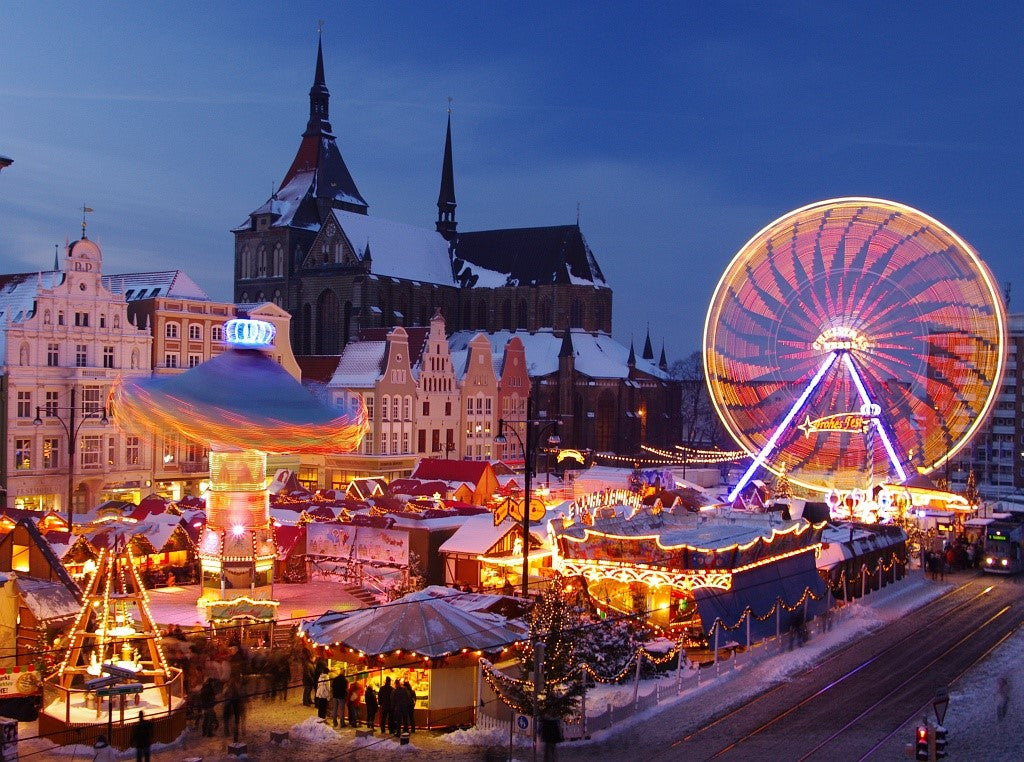
The Christmas season is slowly approaching, meaning that Christmas street markets will be starting up soon! The Christmas street markets are a great place to enjoy the yuletide atmosphere and be surrounded by gingerbread, hot chocolate, eggnog, decorations, lights, and other seasonal staples. The Christmas market has become increasingly popular in the United States over the last few centuries, but did you know that it actually originated in Germany during the 14th century? Of course, they don’t call it a “Christmas market.” To the Germans, it’s the “Christkindlmarkt.” If you happen to be in Germany during the Advent season, you must visit the Christkindlmarkt to see how this holiday tradition originated and what it’s evolved into today!
Just like the Christmas markets in other regions, Christkindlmarkt is held in town squares for easy pedestrian access. In the American markets, you usually find modern holiday favorites such as candy canes, gingerbread, hot chocolate, eggnog, and several common foods that you see throughout the year. In Germany, they do things a little differently. Below is quick rundown of the specific things you will find in Christkindlmarkt.
Specialty Foods from Christkindlmarkt

Reibekuchen – Image Courtesy of fogindex on Flickr
Gluhwein: A hot drink made from red wine, mulling spices, and raisins. This is an ancient drink from 1st century Rome, but it was made popular in the Rhine areas of Germany where the Romans traveled through. Common spices for the Gluhwein include cinnamon, vanilla pods, citrus, cloves, and sugar.
Backfisch: Fried fish served in a brötchen (German roll) and remoulade sauce.
Kastanien (or Maronen): roasted chestnuts Reibekuchen: Potato fritters made from a fried concoction of grated potatoes, onions, egg, flour, salt, and pepper. Reibekuchen are also characteristic of the Lower Rhine area.
Gebrannte Mandeln: Candied toasted almonds, coated in caramel and sugar. The Gebrannte Mandeln (or burnt sugar almonds) are cooked fresh in copper kettles then served in small paper cones. While they are still hot and fresh off the kettle, the almonds are softer and slowly become brittle as they cool.
Schokofrüchte: Fruit skewers dipped in chocolate.
Lebkuchen: German gingerbread cookies. Formerly referred to as “honey cakes”, these cookies originated in the late 13th century in Belgium but were taken over by Franconian monks shortly after. This cookie is spicy and its recipe differs for every region of Germany. The most common form of the Lebkuchen is the Numberger Lebkuchen (of the Numberg region).
Magenbrot: Gingerbread biscuits that are darker than the Lebkuchen and have a diamond shape. The pastry has a wheat base and contains flour, baking soda, anise, cinnamon, cloves, nutmeg, honey, and sugar. Magenbrot takes a couple of days to make as the dough is prepared beforehand and then left for an entire night to properly set before being separated and baked.
Bratwurst: German food just can’t quite get away from the bratwurst. During the Christkindlmarkt, the bratwurst is mulled in brandy so it has a sweeter, spicier taste than your standard hotdog.
Eierpunsch: An egg-based alcoholic punch similar to eggnog. It is made from egg yolks, sugar, white wine, vanilla, and custard.
Specialty Crafts Found in Christkindlmarkt

Image Courtesy of Gita22 on Flickr
Zwetschgenmannle: Tiny human figures made of dried plums. The dried plumbs construct the figures’ bodies, arms, and legs while a makeshift mini head is placed atop. They walk that fine line between creepy and adorable.
Nutcracker: Germany is where the wooden soldier nutcracker (or “nussnacker”) design originated. From the lumberyards of Sonneberg and Ezerberge, these iconic devices have been in production for about 200 years. For more information, read our Oktoberfesthaus article about the history of nutcrackers here.
Nativity Scenes: The manger market, or the Kripperlmarkt, sells all sorts of decorations for you to set up your own nativity scene at home. The Kripperlmarkt specializes in carved figurines made from wood of the Oberammergau, Erzgebirge, and Alps.
Christkindlmarkt Folklore Traditions
 Image Courtesy of Dave on Flickr
Image Courtesy of Dave on Flickr
Krampus Run: A German Christmas event just isn’t complete without paying homage to Krampus. For those who don’t know, Krampus is a mythological beast that travels with St. Nicholas during Christmas season. Where St. Nicholas (or Santa Claus) rewards children who have been good, Krampus is the bad cop who punishes the naughty kids. To celebrate this horrifying creature, the Christkindlmarkt hosts a “Krampus Run.” During the Krampus Run, people dress up as Krampus, run through the markets, and show up throughout the evening to scare the attendees. So if you’re wandering through the Christkindlmarkt and you keep getting harassed by Krampus, chances are you’ve misbehaved this year and you have to change your ways.
Santa Claus: Just like American Christmas markets, Santa will often times make a quick appearance to greet the good girls and boys. The Christkindlmarkt Santa dresses slightly differently than America’s Santa, as his style mirrors an older St. Nikolaus style with a long pointy hat (similar to the Pope’s) and red robes.
Where are the Best Christkindlmarkts in Germany? If you want to see the most original and most authentic markets that the season can offer, the Christkindlmarkt is your easy answer. Not only did these markets originate in Germany, but they also have the most culture-specific traditions, foods, and atmosphere. Below is a list of some of the most prestigious Christkindlmarkts. Do yourself a favor and check them out if you’re spending any of the Christmas season in Germany!
Weihnachtsmarkt of Cologne
Striezelmarkt of Dresden
Sternschnuppenmarkt of Wiesbaden
Christkindlmarkt of Munich


1 comment
BBmyself
You must include the Weihnachtszauber at the Gendarmenmarkt in Berlin to this list!